The increasing ubiquity of smartphones, tablets, and other screen-based technologies in today’s world requires a continuous, high-quality range of vision. Patients who have undergone cataract surgery understand the value of having an uninterrupted spectrum from near vision to intermediate vision that allows maximum comfort and ease of use.
A panel comprised of Iqbal Ike K. Ahmed, MD, FRCSC; Jaime Aramberri, MD; Francesco Carones, MD; Takashi Hida, MD, PhD; Frank T. Kerkhoff, MD, PhD; and Milind Pande, DO, FRCS, FRCOphth, Cert LRS, met to review how one particular innovation in cataract surgery—the TECNIS Synergy™ IOL (Johnson & Johnson Vision)—has recently been integrated into their practice. Their candid conversation includes a review of preoperative strategies related to patient assessments and power calculations, a discussion of which intraoperative technologies are most conducive to efficient and effective cataract surgery in the modern era, and a dialogue about postoperative patient management strategies.
My experience: patient satisfaction after tecnis synergy™ iol implantation
Discuss your patients’ overall satisfaction after implantation of the TECNIS Synergy™ IOL.
Iqbal Ike K. Ahmed, MD, FRCSC: Patients who have received the TECNIS Synergy™ IOL in our practice have experienced excellent near vision. Not satisfactory or above-average near vision—excellent near vision. The same could be said for our patients’ range of vision. Before we used the TECNIS Synergy™ IOL, our patients had reported good vision outcomes with various multifocal IOLs. But given the added benefit of excellent near vision without many downsides, my colleagues and I have been very happy with the TECNIS Synergy™ IOL and have used it more and more.
Determining patients’ performance in low-light conditions is always a challenge, as we have to rely on subjective assessments. My patients report proper functioning at night, which we’ve been happy with. Patient selection is key in this regard: I decline to place any presbyopia-correcting IOL in patients who have high demands or whose personalities will not be satisfied with this IOL. Similarly, if my patients react poorly to the possibility of dysphotopsia, then I decline to place a multifocal IOL.
Frank T. Kerkhoff, MD, PhD: Patients who have received the TECNIS Synergy™ IOL in our clinic have also been very happy.
Jaime Aramberri, MD: Reports of near vision and intermediate vision (ie, 40 cm to 1 m) with the TECNIS Synergy™ IOL have been very positive. The TECNIS Synergy™ IOL has provided the best intermediate and near vision of any presbyopia-correcting IOL I’ve used. Our clinic has also been pleased with the consistency of postoperative outcomes.
Our patients have also reported satisfaction with performance in low light. With other presbyopia-correcting IOLs, we have heard complaints of needing additional light while reading. We have not heard this complaint from patients who have the TECNIS Synergy™ IOL, which is why I often use this IOL in patients who prioritize near vision.
Milind Pande, DO, FRCS, FRCOphth, Cert LRS: We routinely measure our patients’ functional vision using the PANFOCAL visual acuity assessment, a protocol developed at my practice. This is performed preoperatively, after the first eye has received an IOL, and again after both eyes are done. Our evaluation measures patients’ distance and intermediate vision in good light, and near vision in good and dim light.
Data we have gathered from using this system show that the TECNIS Synergy™ IOL provides patients with very good vision (from distance through near), and that near vision performance is the best of any presbyopia-correcting IOL I have used over the past 23 years.* In my experience, the dim light near vision performance of the TECNIS Synergy™ IOL gives my patients better contrast, and I find the halos and glare performance to be similar to that of trifocal IOLs on the market.
Takashi Hida, MD, PhD: My patients’ first impressions after surgery are usually positive. In my opinion, the near vision provided by the TECNIS Synergy™ IOL is superior to presbyopia-correcting IOL options.* Two benefits of the TECNIS Synergy™ IOL that jump out to me are the level of forgiveness regarding the reduction in contrast sensitivity loss and the defocus curve results.
PREOPERATIVE PERIOD
What preoperative assessments do you rely on when considering the TECNIS Synergy™ IOL?
Dr. Ahmed: I believe in acquiring a complete assessment of the total ocular anatomy and function before IOL selection. Any of these may affect the performance of any presbyopia-correcting IOL, and I want to be prepared.
I like assessing everything from the ocular surface to the macula, and also detecting any comorbidities. I assess the ocular surface and tear film, and I measure corneal topography and tomography, lens density, and light scatter. I evaluate the macula via optical coherence tomography (OCT). It is also important to detect underlying astigmatism that may not be evident on a less-thorough examination.
Dr. Pande: Testing macular function by OCT is a very important part of the preoperative evaluation, as it allows surgeons to detect subtle issues that could be relevant to postoperative visual performance with any multifocal or presbyopia-correcting IOL.
Dr. Aramberri: Our practice always checks binocularity when assessing eyes that may receive a premium lens such as the TECNIS Synergy™ IOL. We exclude patients with strabismus and low amblyopia. Patients must have BCVA of at least 0.8 (20/25 Snellen) to be eligible for a multifocal IOL in my practice; if a patient has an eye with BCVA less than 0.8 that is attributable to low amblyopia, then we consider them ineligible for a multifocal IOL.
Dr. Kerkhoff: For what reason do you consider them ineligible? I have found that multifocal IOLs have performed well in such patients.
Dr. Aramberri: In my experience with any presbyopia-correcting IOL, whenever binocular summation is not good enough, the chance for patient dissatisfaction increases. We have found that BCVA of 0.8 is a valid clinical threshold to reduce the incidence of unhappy patients due to insufficient visual quality.
Dr. Ahmed: Angle kappa and high-scoring higher order aberrations (HOAs) may play a role for some surgeons. We have looked at this across a broad network of centers in Canada implanting approximately 5,000 to 6,000 multifocal and presbyopic IOLs annually. Looking back on our data, we found that larger angle kappa measurements and high-scoring HOAs did not correlate with postoperative patient satisfaction. Thus, we have placed less emphasis on those two factors during the IOL selection process.
Dr. Aramberri: I agree. The magnitude of angle kappa doesn’t play much of a role for me.
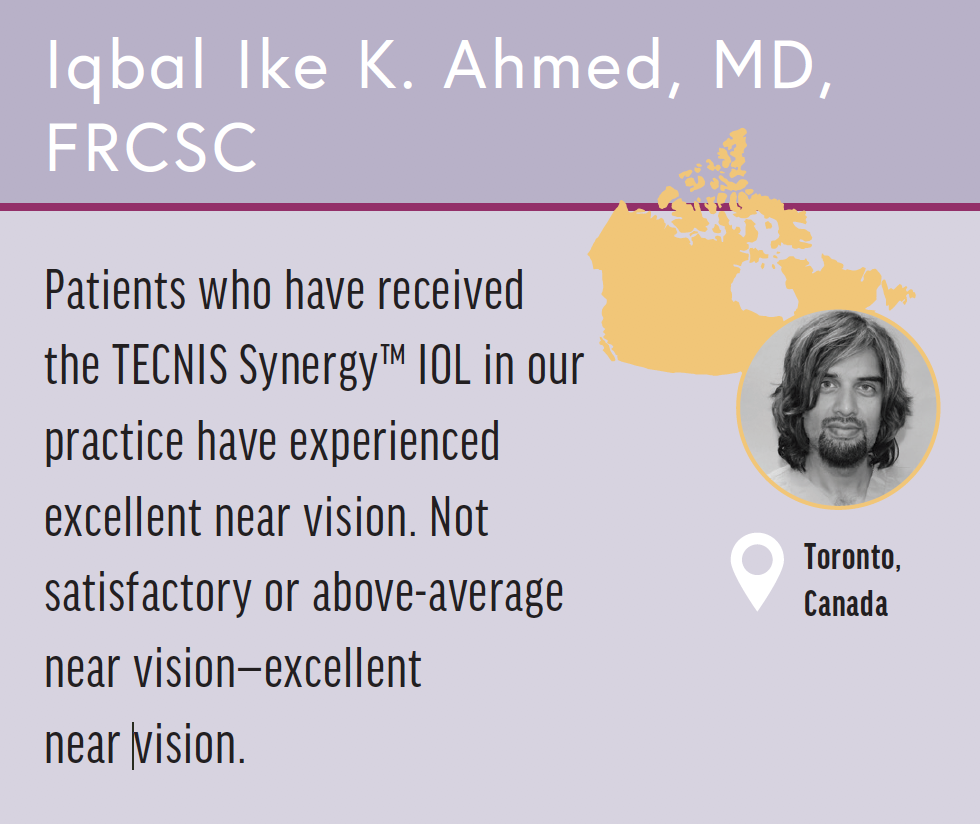
Francesco Carones, MD: I have found the same lack of correlation between angle kappa and patient satisfaction. Regarding high-scoring HOAs, I am cautious and prefer not to implant a diffractive optic IOL. In such cases, I prefer to implant a nondiffractive presbyopia-correcting IOL.
Dr. Ahmed: It’s important to look for astigmatism at this stage, too—even if the patient isn’t seeking to correct it. Residual astigmatism as low as 0.5 D can negatively affect patient satisfaction.
What role does a patient’s lifestyle and personality play in IOL selection?
Dr. Carones: There are two key topics I like to discuss when counseling patients: spectacle independence and dysphotopsia. Most of the patients like the idea of spectacle independence. However, some of them will not accept compromised quality of vision in dim light. Thus, my questions are directed to understand the compromises they are likely to accept to gain spectacle independence.
Dr. Kerkhoff: To me, there are two types of patients: those who spend their days reading indoors and those who have active, outdoor lifestyles. Patients in the indoor group generally receive bilateral TECNIS Synergy™ IOL placement, whereas those who are more active usually receive a monofocal IOL in their dominant eye and a presbyopia-correcting IOL in the contralateral eye.
Dr. Aramberri: Preoperative refractive error plays a major role in my decision tree. Patients with high myopia or hyperopia are not usually the best suited for a multifocal IOL. High myopes may have underlying retinal pathology (or future retinal pathology) that interferes with success, and high hyperopes are generally pleased with monovision.
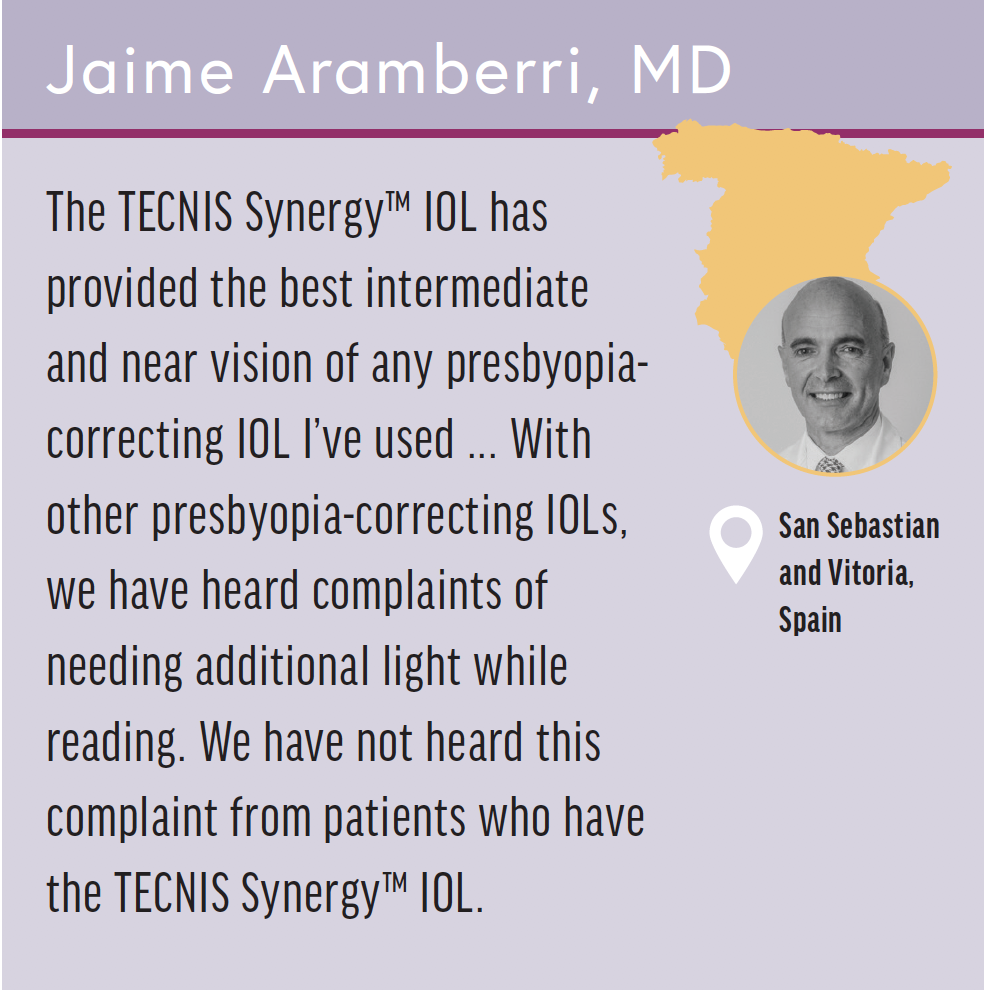
Keeping in mind that our goal is to make our patients as satisfied as possible with any IOL, I would remember that successful cataract surgery balances expectations and reality. Setting preoperative expectations that can realistically be matched in the postoperative period will usually result in success.
Dr. Ahmed: Patient satisfaction is key. In my algorithm, the first question I ask is if I can meet patient expectations. If my team detects that the patient’s postoperative expectations are unusually (or impossibly) high, then I prefer to place a monofocal IOL. If a patient might be a good fit for a presbyopia-correcting IOL, then I discuss the potential for nighttime visual disturbances, such as halos and glare. I have found that visual aids work well at illustrating what these may mean for a patient. If they’re still on board after that, then we screen them for any comorbidities that may interfere with presbyopia-correcting IOL success or any occupational issues that could guide us toward a particular technology. If they clear all of these requirements, then the TECNIS Synergy™ IOL is likely going to be a good fit for them.
Dr. Hida: Questionnaires before surgery can be helpful in this regard. When it comes to personalized surgery, I try to gather as much information as I can. In a recent case, I customized two IOLs in a patient who was a photographer. We continue to see advancements in camera technology, photographic techniques, and lighting equipment. The wide variety of available TECNIS® Family IOLs (ie, IOLs including the TECNIS Synergy™ ZFR00V; TECNIS® Multifocal ZMB00, ZKB00, and ZLB00; TECNIS Symfony™ Extended Range of Vision IOL ZXR00; TECNIS Eyhance™ ICB00; and TECNIS® Monofocal ZCB00 [all Johnson & Johnson Vision])1-7 may be customized to an appropriate quality of vision for each individual.
Dr. Ahmed: I have moved away from that type of personalization thanks to the TECNIS Synergy™ IOL. Because this technology covers a wide array of focal distances, I’ve stopped mixing and matching particular technologies with individual patients.
Dr. Pande: The fact is that there is no single lens which provides the patient with perfect vision at all distances and levels of illumination. The TECNIS Synergy™ IOL provides the widest range of vision among presbyopia-correcting IOLs—like PanOptix (Alcon), TECNIS® Multifocal, or TECNIS Symfony™ IOLs—with levels of contrast reduction and glare similar to trifocal IOLs. The TECNIS Eyhance™ IOL, on the other hand, offers a slight extension of the depth of focus, while preserving high contrast and reducing halos and glare, similar to an aspheric monofocal IOL. I believe in binocular customization of IOLs and/or refractive targeting to get my patients a full range of vision—from infinity to 40 cm—with the highest possible contrast levels and the least amount of dysphotopsia (ie, glare and halos).
After placing the TECNIS Synergy™ IOL in one eye, I assess the patient’s functional vision, objective task performance, and personal experience. If they’re happy—which occurs most of the time—then I place another TECNIS Synergy™ IOL. If the patient is very happy with their near vision but feels their distance vision needs to be improved or is concerned about night driving due to glares and halos, then I place a TECNIS Eyhance™ IOL in the contralateral eye. Using the TECNIS Eyhance™ IOL in this patient preserves the near visual gains offered by the TECNIS Synergy™ IOL and mitigates any concerns about glare, halos, or distance vision. Surgeons need to remain open-minded about implanting a different IOL in the contralateral eye so that they can keep their patients happy. In most patients, we don’t need to use different lenses in each eye, but it is critical to keep in mind that one can use binocular customization to improve patient satisfaction and minimize postoperative patient concerns.
It should be noted that this can work the other way, too. I use the TECNIS Synergy™ IOL to improve near vision performance in patients who have had the TECNIS Eyhance™ IOL implanted in their first eye.
What formula do you use in IOL calculations? Do you use the recommended A-constant or have you optimized your own?
Dr. Pande: A full evaluation of the eye includes functional vision assessments, as well as optical diagnostics including pupil size, corneal tomography and topography, ocular and corneal wavefront measurements, axial length, anterior chamber depth, lens thickness, and keratometry. These are used to drive a comprehensive refractive targeting system based on personalized constants for achieving targeted defocus, toricity, and presbyopia correction.
Dr. Aramberri: I use my own formula for calculating IOL power, which is based in numerical ray tracing. As I don’t have curvature data of this IOL, I use a standard lens within the model and adjust the power by the A-constant difference. When I first began implanting the TECNIS Synergy™ IOL, I used the recommended A-constant of 119.3, which I found resulted in slight myopia. Now, I use the A-constant 119.1.
I have learned that the TECNIS Synergy™ IOL performs best if the surgeon aims for emmetropia. Erring on the side of hyperopic placement may also be wise. Slight postoperative myopia seems to interfere with distance vision.
Dr. Kerkhoff: I use the Barrett formula and use the recommended A-constant of 119.3.
Dr. Hida: I use the Barrett formula and the recommended A-constant as well. I aim for emmetropia, or sometimes a bit toward hyperopia.
Dr. Ahmed: I use the Barrett formula. I also use an A-constant of 119.39 when calculating power for the TECNIS® ZLB00 IOL, TECNIS® ZCT IOL, TECNIS Symfony™, and TECNIS Symfony™ Toric IOL. I’ve used that same A-constant for the TECNIS Synergy™ IOL, and I’ve been very happy with it. There’s a beauty to using the same A-constant for a family of IOLs.
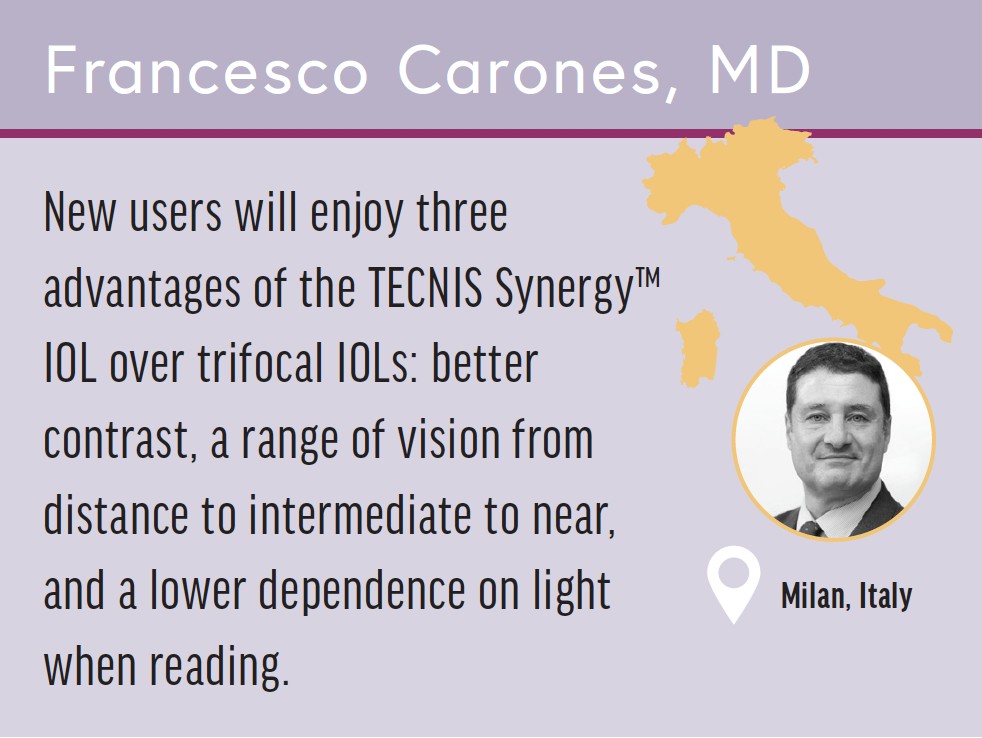
INTRAOPERATIVE CONSIDERATIONS
What technology do you use for IOL alignment?
Dr. Kerkhoff: When performing computer-assisted cataract surgery, my platform of choice is the CALLISTO® (ZEISS).
Dr. Hida: The continued progress of advanced technologies makes us strive for perfection when using digital imaging devices. I perform alignment using a preoperative electronic marking device (ASICO), the ORA System® (Alcon), the CALLISTO® (ZEISS), and the VERION® Image Guided System (Alcon). My recommendation is to use the Purkinje images PI, PIII, and PIV as real-time markers associated with the intraoperative aberrometer refractive readings and centralize between the pupillary central point and the Purkinje images.
Dr. Carones: I use the VERION® Digital Marker (Alcon) to align the toric axis, and I like to center the IOL on the first Purkinje image at the microscope.
Dr. Aramberri: I perform alignment by marking at the slit lamp before surgery. I have used a number of automated systems, but my clinic never found a meaningful difference in outcomes among patients who received manual or automated alignment.
Dr. Ahmed: I do my best to center the IOL on the first Purkinje image. Whether it makes a difference or not, I don’t know. But I feel like it’s the right choice.
Dr. Aramberri: I do intraoperative dilation, and during the end of surgery the pupil tends to become smaller. I center the IOL on the pupil. Others in my clinic use Purkinje images or other centration techniques. We have asked optometrists who manage our postoperative patients if they have noticed a difference in patients that have experienced one centration technique over the other. Generally, they have not noticed a difference.
How often do you use femtosecond laser when implanting the TECNIS Synergy™ IOL?
Dr. Carones: I use the femtosecond laser in nearly 100% of my lens replacement surgeries. Femtosecond use is particularly important when implanting any presbyopia-correcting IOL because a perfectly round and centered capsulorhexis and a consistent incision lead to more predictable refractive outcomes, which optimizes the TECNIS Synergy™ IOL results.
The TECNIS Synergy™ IOL, like trifocal IOLs, is very sensitive to any residual refractive error. Plan your surgery aiming for plano and no residual astigmatism, and take particular care of each surgical step that could lead to a suboptimal refractive outcome, such as the incision, IOL centration, toric axis alignment, and removal of OVD from behind the IOL.
Dr. Pande: Femtosecond laser is my default tool. My clinical impression is that it provides predictable refractive outcomes by increasing the precision of the capsulorhexis. Do not overlook the importance of the foundations of cataract surgery, such as a round 5-mm capsulorhexis (in all patients) and steep meridian identification (in astigmatic patients). A 360° overlap for the capsulorhexis and the TECNIS Synergy™ IOL is much easier to achieve with a femtosecond laser. When placing the TECNIS Synergy™ Toric IOL, the steep meridian must be identified and marked (whether manually or digitally), and the lens must be placed accurately.
Dr. Kerkhoff: I frequently use femtosecond laser. One factor to consider in my practice is that femtosecond laser is an add-on that requires patient payment.
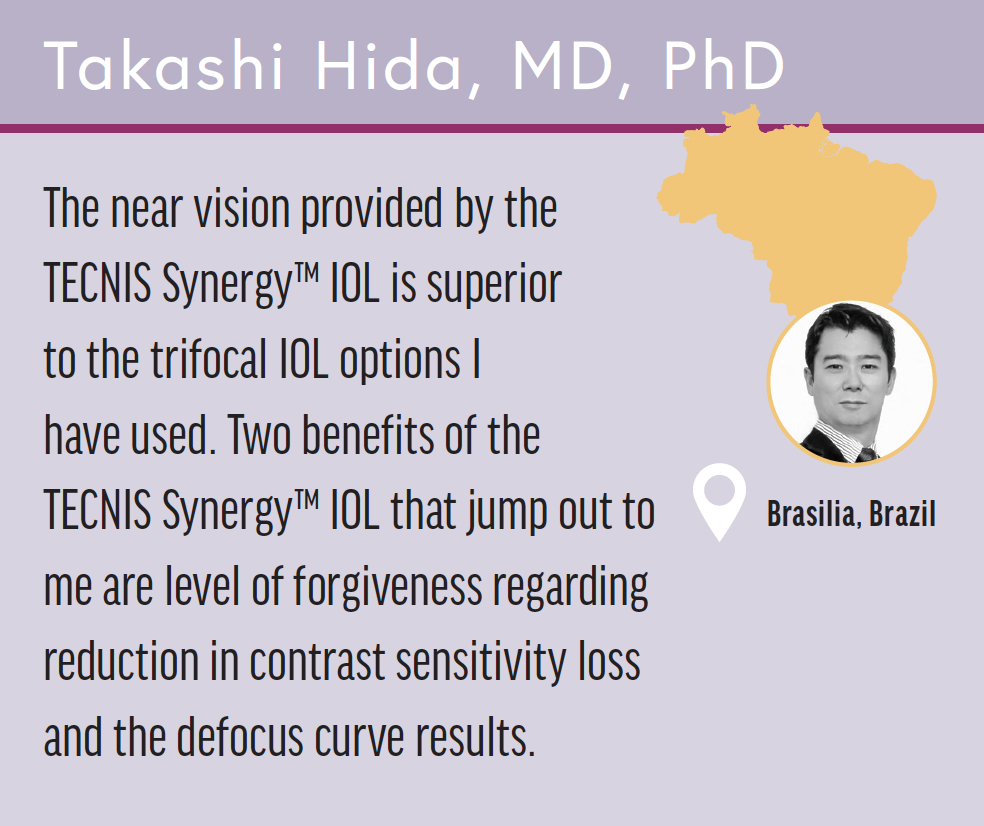
Dr. Aramberri: I used femtosecond laser for a number of years, but at present I only use it in particular cases involving conditions such as very shallow anterior chambers and zonular defects.
Dr. Ahmed: I use femtosecond laser in some cases, and in others I do not. It depends on the OR I am in and on the particulars of the case.
What about intraoperative aberrometry?
Dr. Ahmed: Similar to my use of femtosecond laser, I sometimes do and sometimes do not use intraoperative aberrometry. I believe that surgeons should do whatever keeps their techniques and patterns consistent in order to minimize refractive error.
Dr. Kerkhoff: My practice employed intraoperative aberrometry for a period of time, but my colleagues and I have since stopped using it. We felt that it required too much time and delivered too little benefit.
Dr. Aramberri: My experience is similar to Dr. Kerkhoff’s. I formerly used intraoperative aberrometry, but I found no advantage to using it. Given the time-consuming nature of the modality, I have declined to use it since.
Dr. Carones: I agree with my colleagues: I do not use intraoperative aberrometry.
Dr. Pande: I, too, do not use intraoperative aberrometry. In my opinion, the added expense and time of performing an intraoperative aberrometry does not provide adequate value to use in routine practice.
Dr. Hida: It should be stressed that intraoperative aberrometry is a great tool when placing toric IOLs. To this end, I use the ORA System. I find that readings are consistent with the ORA System. Rotation, positioning, and centering are all easier on this platform when managing astigmatic patients. We should keep this in mind when using a toric version of the TECNIS Synergy™ IOL.
POSTOPERATIVE PERIOD
Have patients reported any dissatisfaction with the lens?
Dr. Aramberri: Some of our patients take a while to adjust to distance vision, even if they’re emmetropic. For many of these patients, their preoperative distance BCVA was 20/20. Perhaps the baseline against which they compare their postoperative distance vision contributes to their need to adjust.

If a patient reports disruptive dysphotopsia after placement of any presbyopia-correcting IOL, I ask that they return in 6 months. During that period, most patients will adjust and be comfortable. A few others, however, cannot tolerate it. Those patients undergo explantation of their presbyopia-correcting IOL, which is replaced with a monofocal IOL. Our explantation rate of presbyopia-correcting IOLs is approximately 1 in 400, and this incidence is similar for different multifocal technologies.
Dr. Kerkhoff: In my experience, other trifocal IOLs also have problems with distance visual acuity as Dr. Aramberri describes. I have noticed, however, that some of my patients struggle with shiny surfaces after implantation of the TECNIS Synergy™ IOL that I have not seen with trifocal IOLs. I have also noticed a cellophane-like capsular reaction in a few of our younger patients quite early after implantation. These patients reported issues with distance and near vision. YAG capsulotomy very soon after surgery has resolved this issue, and the patients report no further visual disruption after this was completed.
Dr. Ahmed: When patients complain of distance vision issues, I often look at refractive error first. Issues on the ocular surface may also lead to light scatter. When patients observe dysphotopsia, I examine them for decentration. If they do indeed need an adjustment, I will reposition the IOL as needed. This has, in my experience, sometimes led to resolution of this unwanted consequence. Touch-ups are always an option, too, but I should note that our rate of postoperative LASIK touch-ups is less than 1% when placing the TECNIS Synergy™ IOL.
Dr. Hida: So far, nobody has reported any dissatisfaction with the TECNIS Synergy™ IOL in my practice. Despite efforts to consistently deliver an excellent visual outcome, some complaints arise among some patients with premium IOLs. Patients who receive IOLs correcting presbyopia and astigmatism sometimes hold high expectations. We know that proper patient selection is critical to success with multifocal lenses. And remember that although the surgery may have gone perfectly for the surgeon, the patient’s postoperative experience may not always be perfect. Our research center collaborates with engineers, scientists, and IT professionals in a multicenter project leveraging artificial intelligence to match the proper IOL to patient expectations. Creative technologies such as this may maximize the likelihood of success in our future practice.
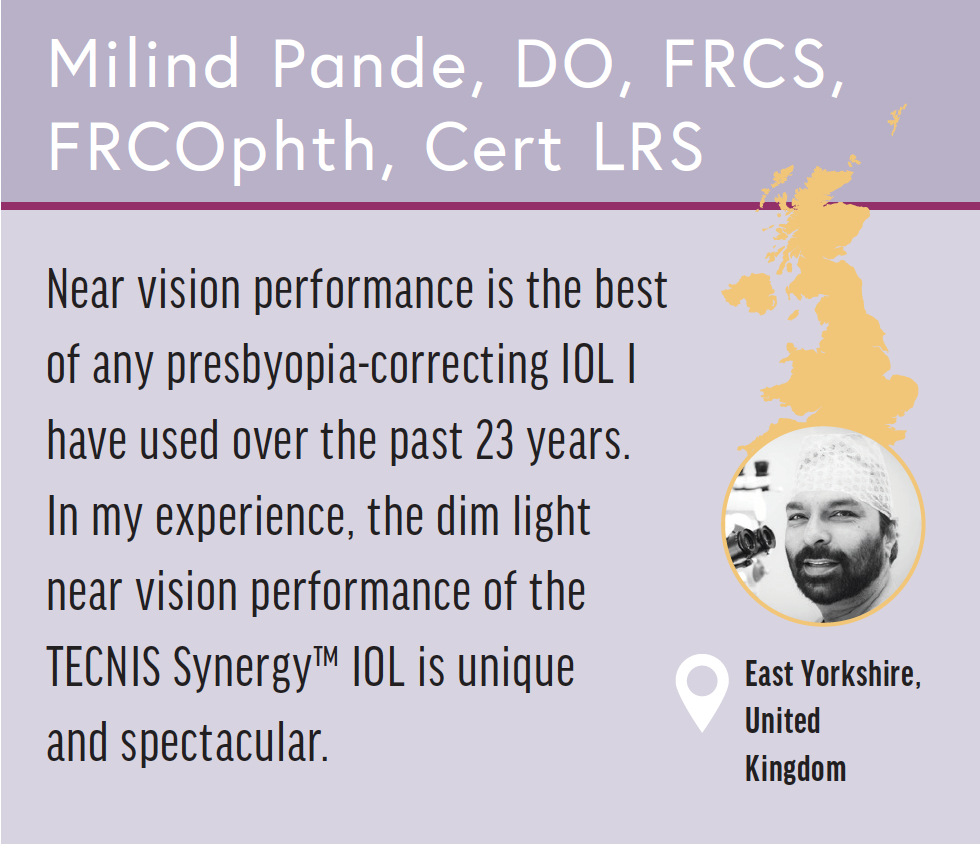
What experiences does the panel have regarding a TECNIS Synergy™ IOL in one eye and a different IOL in the contralateral eye?
Dr. Aramberri: In about a dozen patients, I have placed the TECNIS Synergy™ IOL alongside the TECNIS® ZLB00 IOL in order to account for potential dissatisfaction with distance vision, as the ZLB00 appears to perform better at distance vision. This combination works perfectly and is a good option for patients who demand good distance vision but also require excellent reading ability.
Dr. Kerkhoff: I have provided many patients with a monofocal IOL in one eye and a multifocal lens in the contralateral eye, which is a combination that works well for patients who expect very good distance visual acuity. Providing patients with, for example, the TECNIS Eyhance™ IOL as their monofocal lens in their dominant eye and the TECNIS Synergy™ IOL as the presbyopia-correcting lens in their nondominant eye yields great near, intermediate, and distance vision.
Dr. Pande: Assessing patient satisfaction with a series of functional tests has proven useful in my practice. Before surgery, patients read from a computer screen, a newspaper, a book, and magazine with glossy pages. After their first eye is finished, they repeat the test and report on their visual gaps. We use data from this evaluation to generate a strategy for the second eye to fill those gaps. This involves customizing the lens and/or the refractive targeting for the second eye. These tests are repeated after the second eye surgery to assess the outcome with binocular customization.
These tests allow patients to understand their visual performance and needs and to track their own progress after one eye and both eyes have undergone operation. Our data show that about 95% of our patients are practically free of spectacles and extremely happy with their results.
Dr. Ahmed: When a patient leaves the OR without spectacles, both the patient and surgeon experience an immensely satisfying feeling. They, in turn, tell their friends and family about their new spectacle-free life, which is enhanced by using an IOL that performs well at all distances—especially near distances—in a continuous manner.
How does the TECNIS Synergy™ IOL compare with other advanced IOL technologies in terms of long-term patient satisfaction?
Dr. Carones: I have routinely used all of the trifocal IOLs on the market for many years. All of them perform similarly and have some small drawbacks, including dysphotopsia, contrast sensitivity, three distinct focal points, light dependence for reading, and low tolerance to residual refractive errors. Although the TECNIS Synergy™ IOL has a similar dysphotopsia profile and is similarly sensitive to residual refractive errors, it provides better contrast sensitivity, a continuous range of vision (with no worse focal points), and less light dependence compared with trifocal IOLs that I have used.
Dr. Aramberri: For years, I used the FineVision IOL (PhysIOL) as my trifocal IOL of choice. Since I’ve started using the TECNIS Synergy™ IOL, I have found that my patients are very satisfied with near and intermediate vision, even if some anecdotal evidence points to slightly better distance vision with the FineVision IOL. Still, weighing all of that, the TECNIS Synergy™ IOL is my presbyopia-correcting IOL of choice.
Dr. Kerkhoff: My general preference has been for hydrophilic trifocal lenses—such as the AT LISA (ZEISS)—as they have provided less halo and glare effects compared with their hydrophobic counterparts. However, my recent experience with the TECNIS Synergy™ IOL has me trending toward greater use of this lens. Patient satisfaction with intermediate and near vision has been high. Reading ease is particularly important, and the area in which TECNIS Synergy™ IOL patients are able to read is wider.
Dr. Ahmed: I’m glad that Dr. Kerkhoff mentioned the lens material. I like the hydrophobic design of the TECNIS® IOL family. Perhaps prior negative experiences with calcification of hydrophilic materials—even if those materials have improved over time—have left me with a particular impression of hydrophilic lenses.
Dr. Hida: Given that we know that IOL material may be linked to posterior capsule opacification and calcification—and to incidence of halo, glare, or starburst—we have to be confident that the IOLs we use are made of materials we trust. The TECNIS® family of IOLs uses materials we can trust in our mission to provide excellent visual performance and optical quality.
What final observations do you think new users of the TECNIS Synergy™ IOL should know?
Dr. Ahmed: You have to remember that this lens is not for all patients. Patient selection is key. In our premium practice, less than 25% of patients receive the TECNIS Synergy™ IOL. Remember that the same contraindications that exist for other presbyopia-correcting IOLs apply to the TECNIS Synergy™ IOL. But also remember that the excellent performance of the TECNIS Synergy™ IOL differentiates this IOL from other members of its class.
Dr. Aramberri: I have two pearls to offer: one that concerns IOL selection and another that is more general. First, avoid postoperative against-the-rule astigmatism in low astigmatic corneas (0.5 D or less), checking carefully for total corneal astigmatism and natural lens tilt. Preoperative refractive astigmatism may hint as to what is going on and can be a valuable predictor of later success. A 1.0 D or 1.5 D TECNIS Synergy™ Toric IOL will provide a perfect result in such cases.
Second, understanding the distance-intermediate-near performance of this IOL is important for a correct clinical indication. I would say that near and intermediate vision are excellent and a little better than distance. This knowledge allows me to correctly define patients’ expectations during preoperative discussions—and that is a key factor for success in this surgery.
Dr. Pande: New users must understand what the TECNIS Synergy™ IOL can do and what it can’t do. They must use this understanding to inform their patients in the presurgical period of the quality of vision they can realistically expect. I would recommend starting with implantation in nondominant eyes of hyperopic patients. Like all multifocal and trifocal lenses, it is critical to hit emmetropia with this lens, as even small residual refractive errors can lead to unhappy patients.
Dr. Carones: New users who have been implanting trifocals will be amazed by the TECNIS Synergy™ IOL. Patient counseling and indications don’t differ significantly between trifocal IOLs and the TECNIS Synergy™ IOL, and new users will enjoy three advantages of the TECNIS Synergy™ IOL over trifocal IOLs: better contrast, a range of vision from distance to intermediate to near, and a lower dependence on light when reading.
Surgeons who have implanted trifocal IOLs have already learned how to screen out patients who are not good candidates for advanced technology. For surgeons who are not too familiar with trifocal or other diffractive IOL technology, I suggest starting cautiously and selecting optimal cases first, such as patients with midrange ocular axial length, no astigmatism, a healthy ocular surface, and an easygoing personality. After these surgeons build on their experience, they may advance to more challenging cases.
Dr. Hida: You must remember that your patient’s lifestyle and preoperative expectations will be closely tied to their postoperative satisfaction. Hunters, golfers, and pilots have different visual demands than those who spend their days reading. Careful patient selection and setting realistic expectations will likely lead to a satisfied patient. And if you can underpromise and overdeliver, then your patient will be even happier.
The content of this article represents the views and experiences of the HCPs and does not necessarily represent the opinion of, and has not been reviewed for accuracy or completeness by, the Johnson & Johnson Medical Device Companies.
For Healthcare Professionals Only. Please reference the Instructions for Use for a complete list of Indications and Important Safety Information and contact our specialists in case of any question.
PP2021CT4368
1. TECNIS Synergy™ ZFR00V IFU
2. TECNIS® Multifocal ZMB00 IFU
3. TECNIS® Multifocal ZKB00 IFU
4. TECNIS® Multifocal ZLB00 IFU
5. TECNIS Symfony™ Extended Range of Vision IOL ZXR00 IFU
6. TECNIS Eyhance™ ICB00 IFU
7. TECNIS® Monofocal ZCB00 IFU
INDICATIONS: The TECNIS Simplicity® Delivery System is used to fold and assist in inserting the TECNIS Synergy™ IOL, which is indicated for primary implantation for the visual correction of aphakia in adult patients, with less than 1 diopter of pre-existing corneal astigmatism, in whom a cataractous lens has been removed. The TECNIS Simplicity® Delivery System is used to fold and assist in inserting the TECNIS Synergy™ Toric II IOLs that are indicated for primary implantation for the visual correction of aphakia and for reduction of refractive astigmatism in adult patients with greater than or equal to 1 diopter of preoperative corneal astigmatism, in whom a cataractous lens has been removed. Compared to an aspheric monofocal lens, the TECNIS Synergy™ IOLs mitigate the effects of presbyopia by providing improved visual acuity at intermediate and near distances to reduce eyeglass wear, while maintaining comparable distance visual acuity. The lens is intended for capsular bag placement only.
WARNINGS: Intraocular lenses may exacerbate an existing condition, may interfere with diagnosis or treatment of a condition or may pose an unreasonable risk to the eyesight of patients. Patients should have well-defined visual needs and be informed of possible visual effects (such as a perception of halo, starburst or glare around lights), which may be expected in nighttime or poor visibility conditions. Patients may perceive these visual effects as bothersome, which, on rare occasions, may be significant enough for the patient to request removal of the IOL. The physician should carefully weigh the potential risks and benefits for each patient. Patients with a predicted postoperative residual astigmatism greater than 1.0 diopter, with or without a toric lens, may not fully benefit in terms of reducing spectacle wear. Rotation of the TECNIS Synergy™ Toric II IOL from its intended axis can reduce its astigmatic correction. Misalignment greater than 30° may increase postoperative refractive cylinder. If necessary, lens repositioning should occur as early as possible, prior to lens encapsulation. The lens and delivery system should be discarded if the lens has been folded within the cartridge for more than 10 minutes. Not doing so may result in the lens being stuck in the cartridge. Do not attempt to disassemble, modify, or alter the delivery system or any of its components, as this can significantly affect the function and/or structural integrity of the design.
PRECAUTIONS: Interpret results with caution when using autorefractors or wavefront aberrometers that utilize infrared light, or when performing a duochrome test. Confirmation of refraction with maximum plus manifest refraction technique is strongly recommended. The ability to perform some eye treatments (e.g., retinal photocoagulation) may be affected by the IOL optical design. The surgeon should target emmetropia, as this lens is designed for optimum visual performance when emmetropia is achieved. The TECNIS Synergy™ IOLs should not be placed in the ciliary sulcus. Carefully remove all viscoelastic and do not over-inflate the capsular bag at the end of the case. Residual viscoelastic and/or over-inflation of the capsular bag may allow the lens to rotate, causing misalignment of the TECNIS Synergy™ Toric II IOL. All preoperative surgical parameters are important when choosing a TECNIS Synergy™ Toric II IOL for implantation, including preoperative keratometric cylinder (magnitude and axis), incision location, the surgeon’s estimated surgically induced astigmatism (SIA) and biometry. Variability in any of the preoperative measurements can influence patient outcomes and the effectiveness of treating eyes with lower amounts of preoperative corneal astigmatism. The effectiveness of TECNIS Synergy™ Toric II IOLs in reducing postoperative residual astigmatism in patients with preoperative corneal astigmatism < 1.0 diopter has not been demonstrated. Patients with a predicted postoperative astigmatism greater than 1.0 D may not be suitable candidates for implantation with the TECNIS Synergy™ and TECNIS Synergy™ Toric II IOLs, as they may not obtain the benefits of reduced spectacle wear or improved intermediate and near vision seen in patients with lower predicted postoperative astigmatism.
ATTENTION: Reference the Directions for Use for a complete listing of Indications and Important Safety Information.









